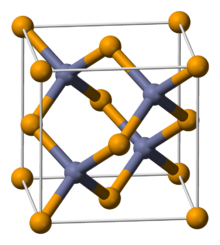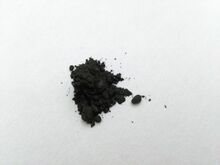Chemistry:Zinc telluride

| |

| |
| Identifiers | |
|---|---|
3D model (JSmol)
|
|
PubChem CID
|
|
| UNII | |
| |
| Properties | |
| ZnTe | |
| Molar mass | 192.99 g/mol[1] |
| Appearance | red crystals |
| Density | 6.34 g/cm3[1] |
| Melting point | 1,295 °C; 2,363 °F; 1,568 K[1] |
| Band gap | 2.26 eV[2] |
| Electron mobility | 340 cm2/(V·s)[2] |
| Thermal conductivity | 108 mW/(cm·K)[1] |
Refractive index (nD)
|
3.56[2] |
| Structure | |
| Zincblende (cubic) | |
| F43m[1] | |
a = 610.1 pm[1]
| |
| Tetrahedral (Zn2+) Tetrahedral (Te2−)[1] | |
| Thermochemistry | |
Heat capacity (C)
|
264 J/(kg·K)[1] |
| Related compounds | |
Other anions
|
Zinc oxide Zinc sulfide Zinc selenide |
Other cations
|
Cadmium telluride Mercury telluride |
Related compounds
|
Cadmium zinc telluride |
Except where otherwise noted, data are given for materials in their standard state (at 25 °C [77 °F], 100 kPa). | |
| Infobox references | |
Zinc telluride is a binary chemical compound with the formula ZnTe. This solid is a semiconductor material with a direct band gap of 2.26 eV.[2] It is usually a p-type semiconductor. Its crystal structure is cubic, like that for sphalerite and diamond.[1]
Properties

ZnTe has the appearance of grey or brownish-red powder, or ruby-red crystals when refined by sublimation. Zinc telluride typically has a cubic (sphalerite, or "zincblende") crystal structure, but can be also prepared as rocksalt crystals or in hexagonal crystals (wurtzite structure). Irradiated by a strong optical beam burns in presence of oxygen. Its lattice constant is 0.6101 nm, allowing it to be grown with or on aluminium antimonide, gallium antimonide, indium arsenide, and lead selenide. With some lattice mismatch, it can also be grown on other substrates such as GaAs,[4] and it can be grown in thin-film polycrystalline (or nanocrystalline) form on substrates such as glass, for example, in the manufacture of thin-film solar cells. In the wurtzite (hexagonal) crystal structure, it has lattice parameters a = 0.427 and c = 0.699 nm.[5]
Applications
Optoelectronics
Zinc telluride can be easily doped, and for this reason it is one of the more common semiconducting materials used in optoelectronics. ZnTe is important for development of various semiconductor devices, including blue LEDs, laser diodes, solar cells, and components of microwave generators. It can be used for solar cells, for example, as a back-surface field layer and p-type semiconductor material for a CdTe/ZnTe structure[6] or in PIN diode structures.
The material can also be used as a component of ternary semiconductor compounds, such as CdxZn(1-x)Te (conceptually a mixture composed from the end-members ZnTe and CdTe), which can be made with a varying composition x to allow the optical bandgap to be tuned as desired.
Nonlinear optics
Zinc telluride together with lithium niobate is often used for generation of pulsed terahertz radiation in time-domain terahertz spectroscopy and terahertz imaging. When a crystal of such material is subjected to a high-intensity light pulse of subpicosecond duration, it emits a pulse of terahertz frequency through a nonlinear optical process called optical rectification.[7] Conversely, subjecting a zinc telluride crystal to terahertz radiation causes it to show optical birefringence and change the polarization of a transmitting light, making it an electro-optic detector.
Vanadium-doped zinc telluride, "ZnTe:V", is a non-linear optical photorefractive material of possible use in the protection of sensors at visible wavelengths. ZnTe:V optical limiters are light and compact, without complicated optics of conventional limiters. ZnTe:V can block a high-intensity jamming beam from a laser dazzler, while still passing the lower-intensity image of the observed scene. It can also be used in holographic interferometry, in reconfigurable optical interconnections, and in laser optical phase conjugation devices. It offers superior photorefractive performance at wavelengths between 600 and 1300 nm, in comparison with other III-V and II-VI compound semiconductors. By adding manganese as an additional dopant (ZnTe:V:Mn), its photorefractive yield can be significantly increased.
References
- ↑ 1.0 1.1 1.2 1.3 1.4 1.5 1.6 1.7 1.8 Haynes, William M., ed (2011). CRC Handbook of Chemistry and Physics (92nd ed.). Boca Raton, FL: CRC Press. p. 12.80. ISBN 1439855110.
- ↑ 2.0 2.1 2.2 2.3 Haynes, William M., ed (2011). CRC Handbook of Chemistry and Physics (92nd ed.). Boca Raton, FL: CRC Press. p. 12.85. ISBN 1439855110.
- ↑ Kanazawa, K.; Yoshida, S.; Shigekawa, H.; Kuroda, S. (2015). "Dynamic probe of ZnTe(110) surface by scanning tunneling microscopy". Science and Technology of Advanced Materials 16 (1): 015002. doi:10.1088/1468-6996/16/1/015002. PMID 27877752. Bibcode: 2015STAdM..16a5002K.
- ↑ O'Dell, Dakota (2010). MBE Growth and Characterization of ZnTe and Nitrogen-doped ZnTe on GaAs(100) Substrates, Department of Physics, University of Notre Dame.
- ↑ Kittel, C. (1976) Introduction to Solid State Physics, 5th edition, p. 28.
- ↑ Amin, N.; Sopian, K.; Konagai, M. (2007). "Numerical modeling of CdS/Cd Te and CdS/Cd Te/Zn Te solar cells as a function of Cd Te thickness". Solar Energy Materials and Solar Cells 91 (13): 1202. doi:10.1016/j.solmat.2007.04.006.
- ↑ THz Generation and Detection in ZnTe. chem.yale.edu
External links
- National Compound Semiconductor Roadmap (Office of Naval research) – Accessed April 2006
 |

